Nursing Reflection Paper
VerifiedAdded on 2023/01/18
|10
|3428
|49
AI Summary
This essay reflects critically on the practice of catheterization in a healthcare setting using Gibbs reflection model. It discusses the process, feelings, evaluation, analysis, and action plan.
Contribute Materials
Your contribution can guide someone’s learning journey. Share your
documents today.

[Company name] [Company address]
Secure Best Marks with AI Grader
Need help grading? Try our AI Grader for instant feedback on your assignments.
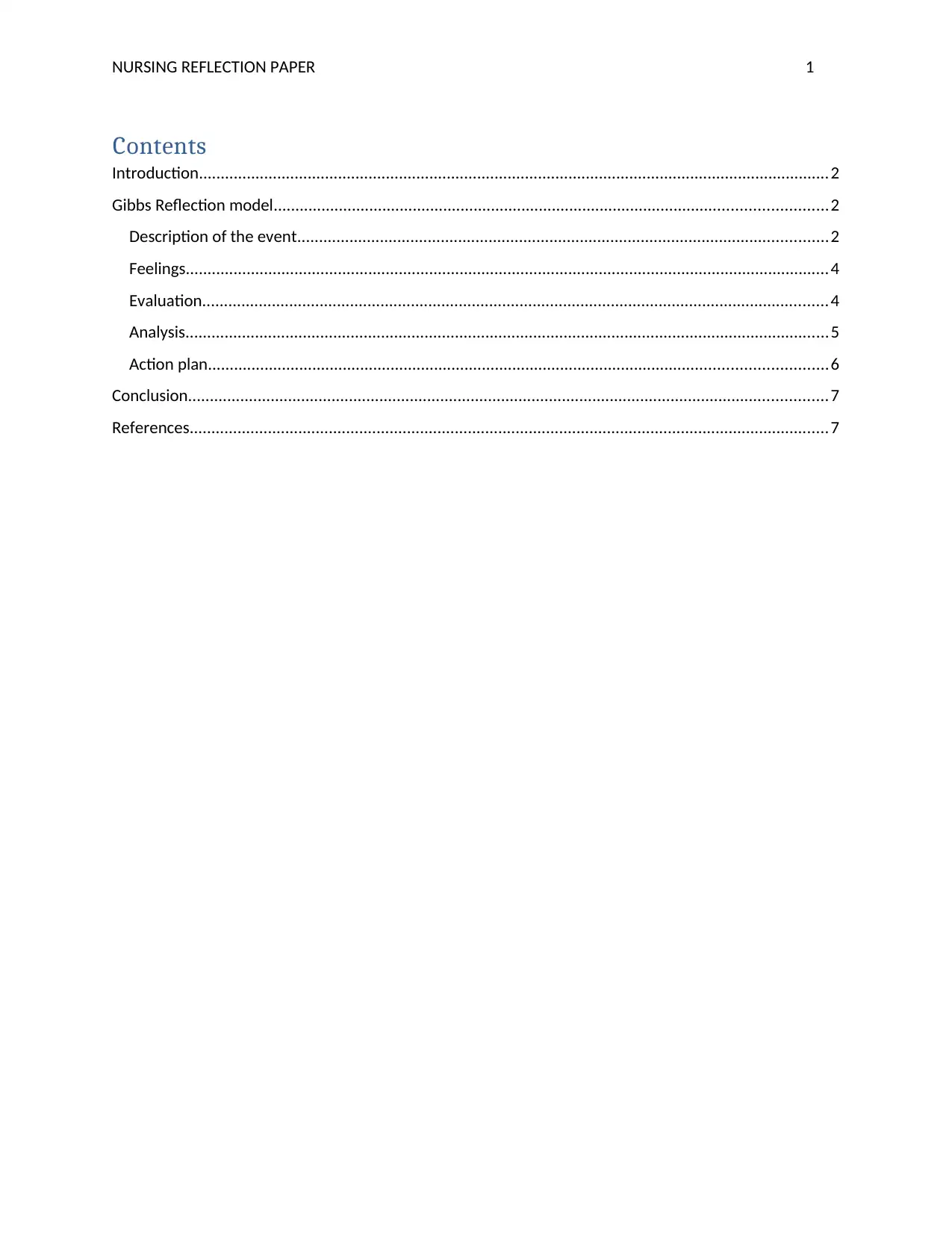
NURSING REFLECTION PAPER 1
Contents
Introduction.................................................................................................................................................2
Gibbs Reflection model...............................................................................................................................2
Description of the event..........................................................................................................................2
Feelings....................................................................................................................................................4
Evaluation................................................................................................................................................4
Analysis....................................................................................................................................................5
Action plan..............................................................................................................................................6
Conclusion...................................................................................................................................................7
References...................................................................................................................................................7
Contents
Introduction.................................................................................................................................................2
Gibbs Reflection model...............................................................................................................................2
Description of the event..........................................................................................................................2
Feelings....................................................................................................................................................4
Evaluation................................................................................................................................................4
Analysis....................................................................................................................................................5
Action plan..............................................................................................................................................6
Conclusion...................................................................................................................................................7
References...................................................................................................................................................7
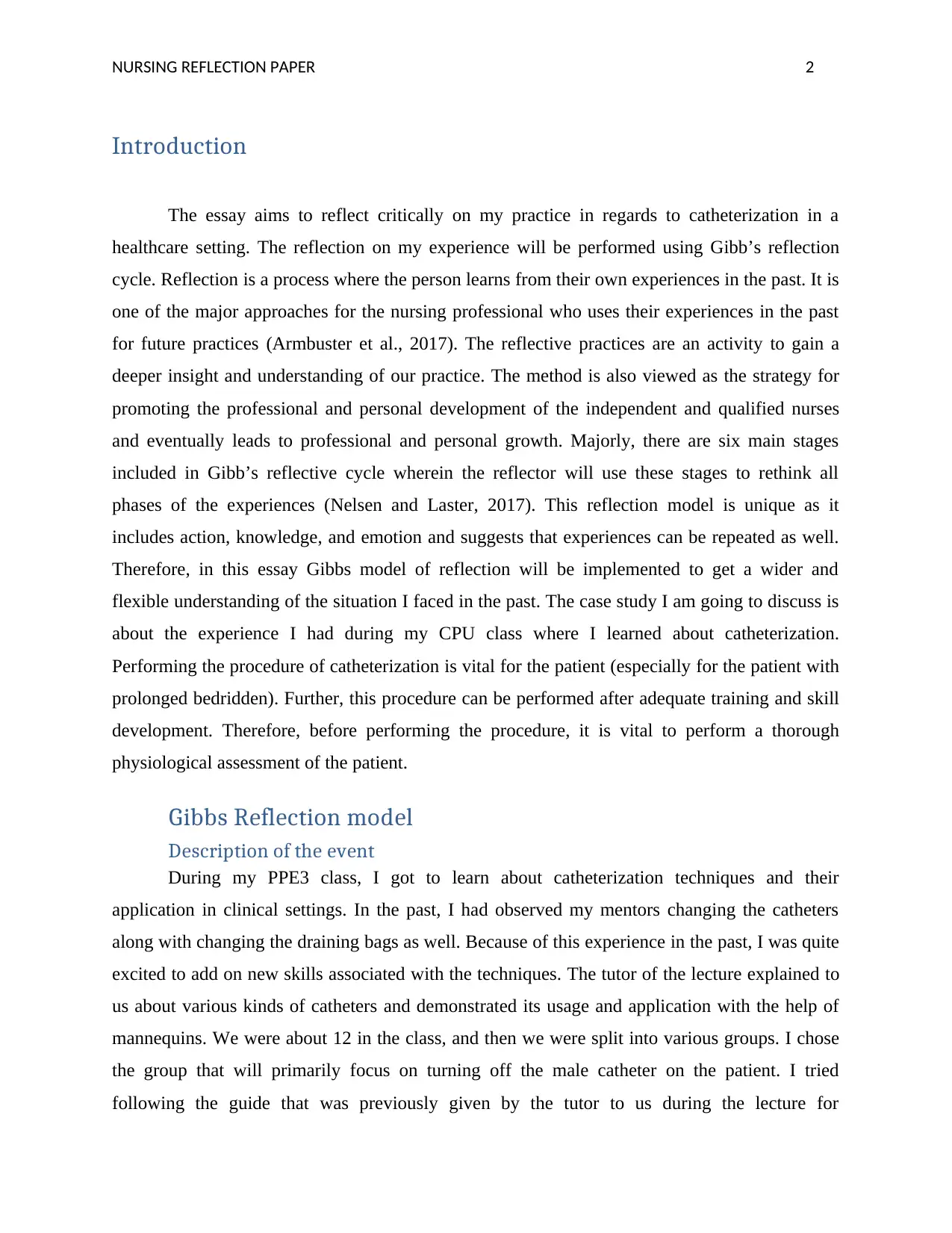
NURSING REFLECTION PAPER 2
Introduction
The essay aims to reflect critically on my practice in regards to catheterization in a
healthcare setting. The reflection on my experience will be performed using Gibb’s reflection
cycle. Reflection is a process where the person learns from their own experiences in the past. It is
one of the major approaches for the nursing professional who uses their experiences in the past
for future practices (Armbuster et al., 2017). The reflective practices are an activity to gain a
deeper insight and understanding of our practice. The method is also viewed as the strategy for
promoting the professional and personal development of the independent and qualified nurses
and eventually leads to professional and personal growth. Majorly, there are six main stages
included in Gibb’s reflective cycle wherein the reflector will use these stages to rethink all
phases of the experiences (Nelsen and Laster, 2017). This reflection model is unique as it
includes action, knowledge, and emotion and suggests that experiences can be repeated as well.
Therefore, in this essay Gibbs model of reflection will be implemented to get a wider and
flexible understanding of the situation I faced in the past. The case study I am going to discuss is
about the experience I had during my CPU class where I learned about catheterization.
Performing the procedure of catheterization is vital for the patient (especially for the patient with
prolonged bedridden). Further, this procedure can be performed after adequate training and skill
development. Therefore, before performing the procedure, it is vital to perform a thorough
physiological assessment of the patient.
Gibbs Reflection model
Description of the event
During my PPE3 class, I got to learn about catheterization techniques and their
application in clinical settings. In the past, I had observed my mentors changing the catheters
along with changing the draining bags as well. Because of this experience in the past, I was quite
excited to add on new skills associated with the techniques. The tutor of the lecture explained to
us about various kinds of catheters and demonstrated its usage and application with the help of
mannequins. We were about 12 in the class, and then we were split into various groups. I chose
the group that will primarily focus on turning off the male catheter on the patient. I tried
following the guide that was previously given by the tutor to us during the lecture for
Introduction
The essay aims to reflect critically on my practice in regards to catheterization in a
healthcare setting. The reflection on my experience will be performed using Gibb’s reflection
cycle. Reflection is a process where the person learns from their own experiences in the past. It is
one of the major approaches for the nursing professional who uses their experiences in the past
for future practices (Armbuster et al., 2017). The reflective practices are an activity to gain a
deeper insight and understanding of our practice. The method is also viewed as the strategy for
promoting the professional and personal development of the independent and qualified nurses
and eventually leads to professional and personal growth. Majorly, there are six main stages
included in Gibb’s reflective cycle wherein the reflector will use these stages to rethink all
phases of the experiences (Nelsen and Laster, 2017). This reflection model is unique as it
includes action, knowledge, and emotion and suggests that experiences can be repeated as well.
Therefore, in this essay Gibbs model of reflection will be implemented to get a wider and
flexible understanding of the situation I faced in the past. The case study I am going to discuss is
about the experience I had during my CPU class where I learned about catheterization.
Performing the procedure of catheterization is vital for the patient (especially for the patient with
prolonged bedridden). Further, this procedure can be performed after adequate training and skill
development. Therefore, before performing the procedure, it is vital to perform a thorough
physiological assessment of the patient.
Gibbs Reflection model
Description of the event
During my PPE3 class, I got to learn about catheterization techniques and their
application in clinical settings. In the past, I had observed my mentors changing the catheters
along with changing the draining bags as well. Because of this experience in the past, I was quite
excited to add on new skills associated with the techniques. The tutor of the lecture explained to
us about various kinds of catheters and demonstrated its usage and application with the help of
mannequins. We were about 12 in the class, and then we were split into various groups. I chose
the group that will primarily focus on turning off the male catheter on the patient. I tried
following the guide that was previously given by the tutor to us during the lecture for
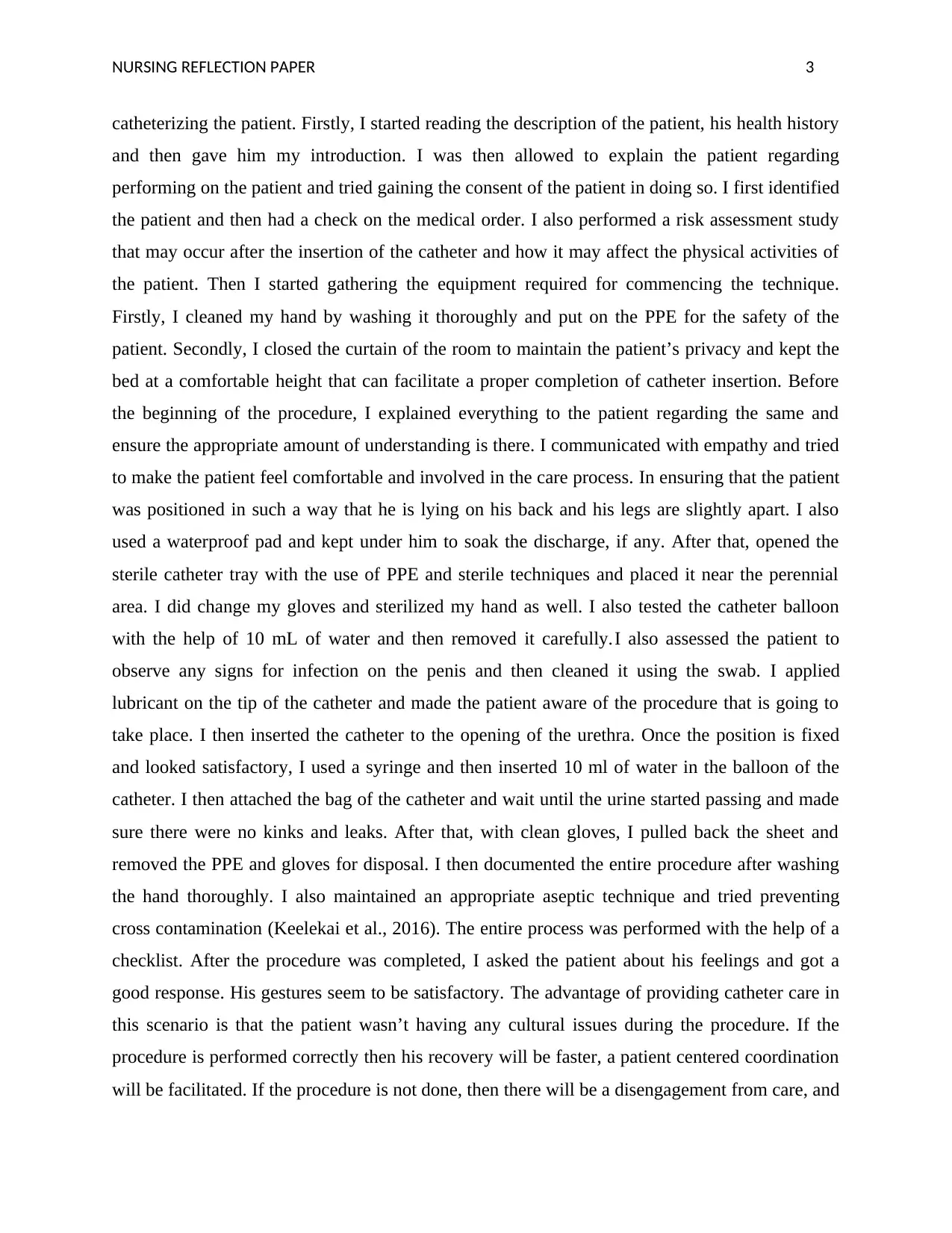
NURSING REFLECTION PAPER 3
catheterizing the patient. Firstly, I started reading the description of the patient, his health history
and then gave him my introduction. I was then allowed to explain the patient regarding
performing on the patient and tried gaining the consent of the patient in doing so. I first identified
the patient and then had a check on the medical order. I also performed a risk assessment study
that may occur after the insertion of the catheter and how it may affect the physical activities of
the patient. Then I started gathering the equipment required for commencing the technique.
Firstly, I cleaned my hand by washing it thoroughly and put on the PPE for the safety of the
patient. Secondly, I closed the curtain of the room to maintain the patient’s privacy and kept the
bed at a comfortable height that can facilitate a proper completion of catheter insertion. Before
the beginning of the procedure, I explained everything to the patient regarding the same and
ensure the appropriate amount of understanding is there. I communicated with empathy and tried
to make the patient feel comfortable and involved in the care process. In ensuring that the patient
was positioned in such a way that he is lying on his back and his legs are slightly apart. I also
used a waterproof pad and kept under him to soak the discharge, if any. After that, opened the
sterile catheter tray with the use of PPE and sterile techniques and placed it near the perennial
area. I did change my gloves and sterilized my hand as well. I also tested the catheter balloon
with the help of 10 mL of water and then removed it carefully.I also assessed the patient to
observe any signs for infection on the penis and then cleaned it using the swab. I applied
lubricant on the tip of the catheter and made the patient aware of the procedure that is going to
take place. I then inserted the catheter to the opening of the urethra. Once the position is fixed
and looked satisfactory, I used a syringe and then inserted 10 ml of water in the balloon of the
catheter. I then attached the bag of the catheter and wait until the urine started passing and made
sure there were no kinks and leaks. After that, with clean gloves, I pulled back the sheet and
removed the PPE and gloves for disposal. I then documented the entire procedure after washing
the hand thoroughly. I also maintained an appropriate aseptic technique and tried preventing
cross contamination (Keelekai et al., 2016). The entire process was performed with the help of a
checklist. After the procedure was completed, I asked the patient about his feelings and got a
good response. His gestures seem to be satisfactory. The advantage of providing catheter care in
this scenario is that the patient wasn’t having any cultural issues during the procedure. If the
procedure is performed correctly then his recovery will be faster, a patient centered coordination
will be facilitated. If the procedure is not done, then there will be a disengagement from care, and
catheterizing the patient. Firstly, I started reading the description of the patient, his health history
and then gave him my introduction. I was then allowed to explain the patient regarding
performing on the patient and tried gaining the consent of the patient in doing so. I first identified
the patient and then had a check on the medical order. I also performed a risk assessment study
that may occur after the insertion of the catheter and how it may affect the physical activities of
the patient. Then I started gathering the equipment required for commencing the technique.
Firstly, I cleaned my hand by washing it thoroughly and put on the PPE for the safety of the
patient. Secondly, I closed the curtain of the room to maintain the patient’s privacy and kept the
bed at a comfortable height that can facilitate a proper completion of catheter insertion. Before
the beginning of the procedure, I explained everything to the patient regarding the same and
ensure the appropriate amount of understanding is there. I communicated with empathy and tried
to make the patient feel comfortable and involved in the care process. In ensuring that the patient
was positioned in such a way that he is lying on his back and his legs are slightly apart. I also
used a waterproof pad and kept under him to soak the discharge, if any. After that, opened the
sterile catheter tray with the use of PPE and sterile techniques and placed it near the perennial
area. I did change my gloves and sterilized my hand as well. I also tested the catheter balloon
with the help of 10 mL of water and then removed it carefully.I also assessed the patient to
observe any signs for infection on the penis and then cleaned it using the swab. I applied
lubricant on the tip of the catheter and made the patient aware of the procedure that is going to
take place. I then inserted the catheter to the opening of the urethra. Once the position is fixed
and looked satisfactory, I used a syringe and then inserted 10 ml of water in the balloon of the
catheter. I then attached the bag of the catheter and wait until the urine started passing and made
sure there were no kinks and leaks. After that, with clean gloves, I pulled back the sheet and
removed the PPE and gloves for disposal. I then documented the entire procedure after washing
the hand thoroughly. I also maintained an appropriate aseptic technique and tried preventing
cross contamination (Keelekai et al., 2016). The entire process was performed with the help of a
checklist. After the procedure was completed, I asked the patient about his feelings and got a
good response. His gestures seem to be satisfactory. The advantage of providing catheter care in
this scenario is that the patient wasn’t having any cultural issues during the procedure. If the
procedure is performed correctly then his recovery will be faster, a patient centered coordination
will be facilitated. If the procedure is not done, then there will be a disengagement from care, and
Secure Best Marks with AI Grader
Need help grading? Try our AI Grader for instant feedback on your assignments.
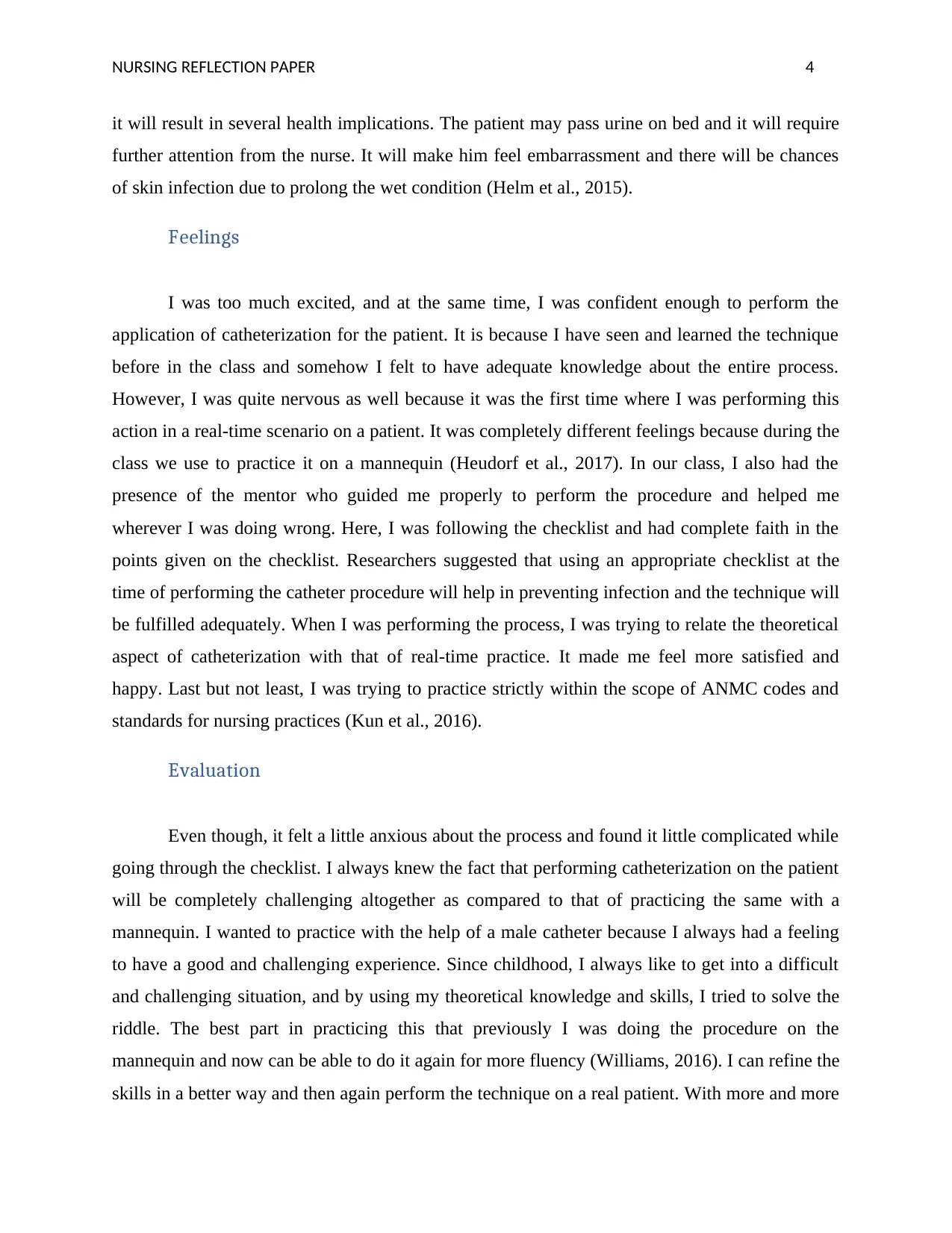
NURSING REFLECTION PAPER 4
it will result in several health implications. The patient may pass urine on bed and it will require
further attention from the nurse. It will make him feel embarrassment and there will be chances
of skin infection due to prolong the wet condition (Helm et al., 2015).
Feelings
I was too much excited, and at the same time, I was confident enough to perform the
application of catheterization for the patient. It is because I have seen and learned the technique
before in the class and somehow I felt to have adequate knowledge about the entire process.
However, I was quite nervous as well because it was the first time where I was performing this
action in a real-time scenario on a patient. It was completely different feelings because during the
class we use to practice it on a mannequin (Heudorf et al., 2017). In our class, I also had the
presence of the mentor who guided me properly to perform the procedure and helped me
wherever I was doing wrong. Here, I was following the checklist and had complete faith in the
points given on the checklist. Researchers suggested that using an appropriate checklist at the
time of performing the catheter procedure will help in preventing infection and the technique will
be fulfilled adequately. When I was performing the process, I was trying to relate the theoretical
aspect of catheterization with that of real-time practice. It made me feel more satisfied and
happy. Last but not least, I was trying to practice strictly within the scope of ANMC codes and
standards for nursing practices (Kun et al., 2016).
Evaluation
Even though, it felt a little anxious about the process and found it little complicated while
going through the checklist. I always knew the fact that performing catheterization on the patient
will be completely challenging altogether as compared to that of practicing the same with a
mannequin. I wanted to practice with the help of a male catheter because I always had a feeling
to have a good and challenging experience. Since childhood, I always like to get into a difficult
and challenging situation, and by using my theoretical knowledge and skills, I tried to solve the
riddle. The best part in practicing this that previously I was doing the procedure on the
mannequin and now can be able to do it again for more fluency (Williams, 2016). I can refine the
skills in a better way and then again perform the technique on a real patient. With more and more
it will result in several health implications. The patient may pass urine on bed and it will require
further attention from the nurse. It will make him feel embarrassment and there will be chances
of skin infection due to prolong the wet condition (Helm et al., 2015).
Feelings
I was too much excited, and at the same time, I was confident enough to perform the
application of catheterization for the patient. It is because I have seen and learned the technique
before in the class and somehow I felt to have adequate knowledge about the entire process.
However, I was quite nervous as well because it was the first time where I was performing this
action in a real-time scenario on a patient. It was completely different feelings because during the
class we use to practice it on a mannequin (Heudorf et al., 2017). In our class, I also had the
presence of the mentor who guided me properly to perform the procedure and helped me
wherever I was doing wrong. Here, I was following the checklist and had complete faith in the
points given on the checklist. Researchers suggested that using an appropriate checklist at the
time of performing the catheter procedure will help in preventing infection and the technique will
be fulfilled adequately. When I was performing the process, I was trying to relate the theoretical
aspect of catheterization with that of real-time practice. It made me feel more satisfied and
happy. Last but not least, I was trying to practice strictly within the scope of ANMC codes and
standards for nursing practices (Kun et al., 2016).
Evaluation
Even though, it felt a little anxious about the process and found it little complicated while
going through the checklist. I always knew the fact that performing catheterization on the patient
will be completely challenging altogether as compared to that of practicing the same with a
mannequin. I wanted to practice with the help of a male catheter because I always had a feeling
to have a good and challenging experience. Since childhood, I always like to get into a difficult
and challenging situation, and by using my theoretical knowledge and skills, I tried to solve the
riddle. The best part in practicing this that previously I was doing the procedure on the
mannequin and now can be able to do it again for more fluency (Williams, 2016). I can refine the
skills in a better way and then again perform the technique on a real patient. With more and more
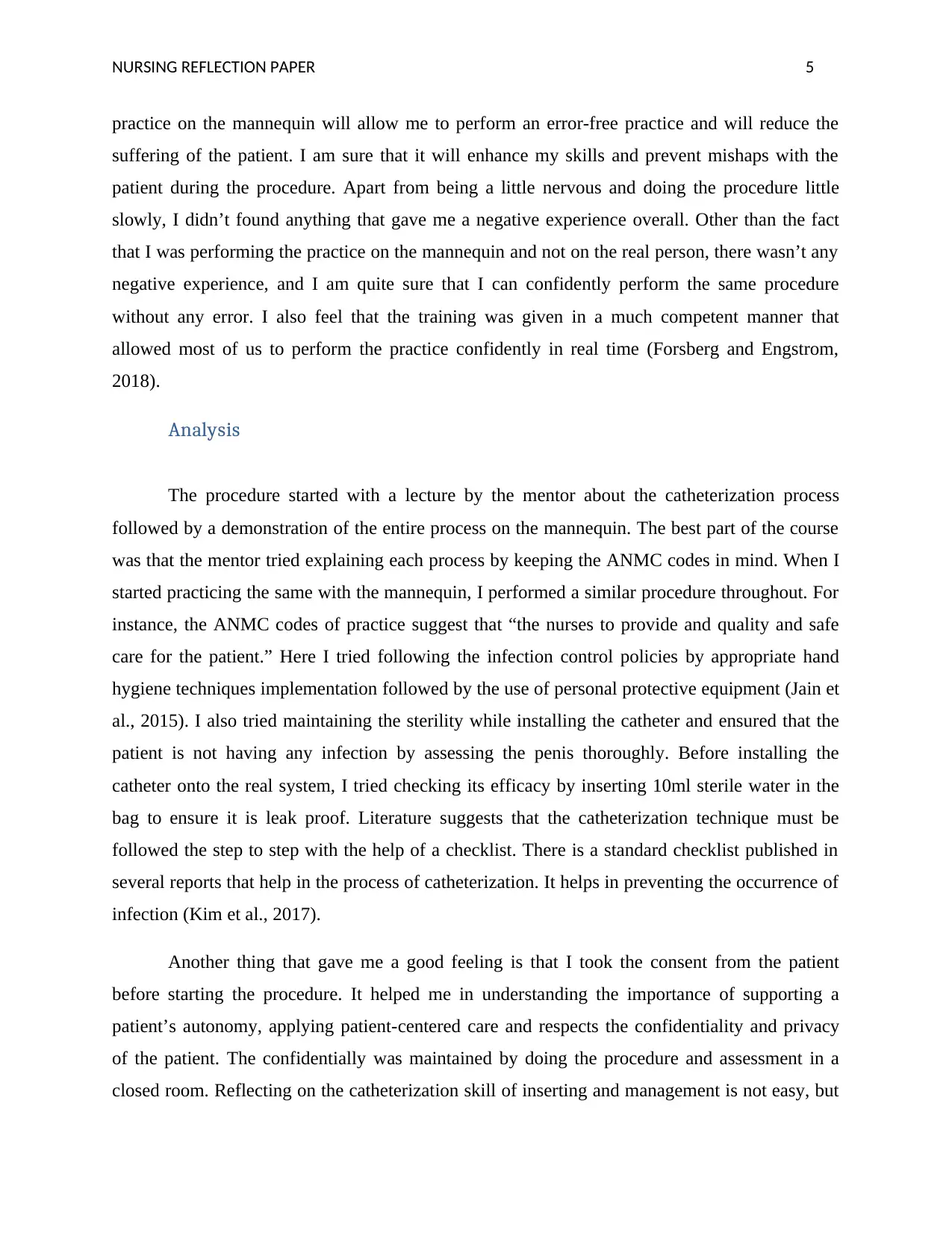
NURSING REFLECTION PAPER 5
practice on the mannequin will allow me to perform an error-free practice and will reduce the
suffering of the patient. I am sure that it will enhance my skills and prevent mishaps with the
patient during the procedure. Apart from being a little nervous and doing the procedure little
slowly, I didn’t found anything that gave me a negative experience overall. Other than the fact
that I was performing the practice on the mannequin and not on the real person, there wasn’t any
negative experience, and I am quite sure that I can confidently perform the same procedure
without any error. I also feel that the training was given in a much competent manner that
allowed most of us to perform the practice confidently in real time (Forsberg and Engstrom,
2018).
Analysis
The procedure started with a lecture by the mentor about the catheterization process
followed by a demonstration of the entire process on the mannequin. The best part of the course
was that the mentor tried explaining each process by keeping the ANMC codes in mind. When I
started practicing the same with the mannequin, I performed a similar procedure throughout. For
instance, the ANMC codes of practice suggest that “the nurses to provide and quality and safe
care for the patient.” Here I tried following the infection control policies by appropriate hand
hygiene techniques implementation followed by the use of personal protective equipment (Jain et
al., 2015). I also tried maintaining the sterility while installing the catheter and ensured that the
patient is not having any infection by assessing the penis thoroughly. Before installing the
catheter onto the real system, I tried checking its efficacy by inserting 10ml sterile water in the
bag to ensure it is leak proof. Literature suggests that the catheterization technique must be
followed the step to step with the help of a checklist. There is a standard checklist published in
several reports that help in the process of catheterization. It helps in preventing the occurrence of
infection (Kim et al., 2017).
Another thing that gave me a good feeling is that I took the consent from the patient
before starting the procedure. It helped me in understanding the importance of supporting a
patient’s autonomy, applying patient-centered care and respects the confidentiality and privacy
of the patient. The confidentially was maintained by doing the procedure and assessment in a
closed room. Reflecting on the catheterization skill of inserting and management is not easy, but
practice on the mannequin will allow me to perform an error-free practice and will reduce the
suffering of the patient. I am sure that it will enhance my skills and prevent mishaps with the
patient during the procedure. Apart from being a little nervous and doing the procedure little
slowly, I didn’t found anything that gave me a negative experience overall. Other than the fact
that I was performing the practice on the mannequin and not on the real person, there wasn’t any
negative experience, and I am quite sure that I can confidently perform the same procedure
without any error. I also feel that the training was given in a much competent manner that
allowed most of us to perform the practice confidently in real time (Forsberg and Engstrom,
2018).
Analysis
The procedure started with a lecture by the mentor about the catheterization process
followed by a demonstration of the entire process on the mannequin. The best part of the course
was that the mentor tried explaining each process by keeping the ANMC codes in mind. When I
started practicing the same with the mannequin, I performed a similar procedure throughout. For
instance, the ANMC codes of practice suggest that “the nurses to provide and quality and safe
care for the patient.” Here I tried following the infection control policies by appropriate hand
hygiene techniques implementation followed by the use of personal protective equipment (Jain et
al., 2015). I also tried maintaining the sterility while installing the catheter and ensured that the
patient is not having any infection by assessing the penis thoroughly. Before installing the
catheter onto the real system, I tried checking its efficacy by inserting 10ml sterile water in the
bag to ensure it is leak proof. Literature suggests that the catheterization technique must be
followed the step to step with the help of a checklist. There is a standard checklist published in
several reports that help in the process of catheterization. It helps in preventing the occurrence of
infection (Kim et al., 2017).
Another thing that gave me a good feeling is that I took the consent from the patient
before starting the procedure. It helped me in understanding the importance of supporting a
patient’s autonomy, applying patient-centered care and respects the confidentiality and privacy
of the patient. The confidentially was maintained by doing the procedure and assessment in a
closed room. Reflecting on the catheterization skill of inserting and management is not easy, but
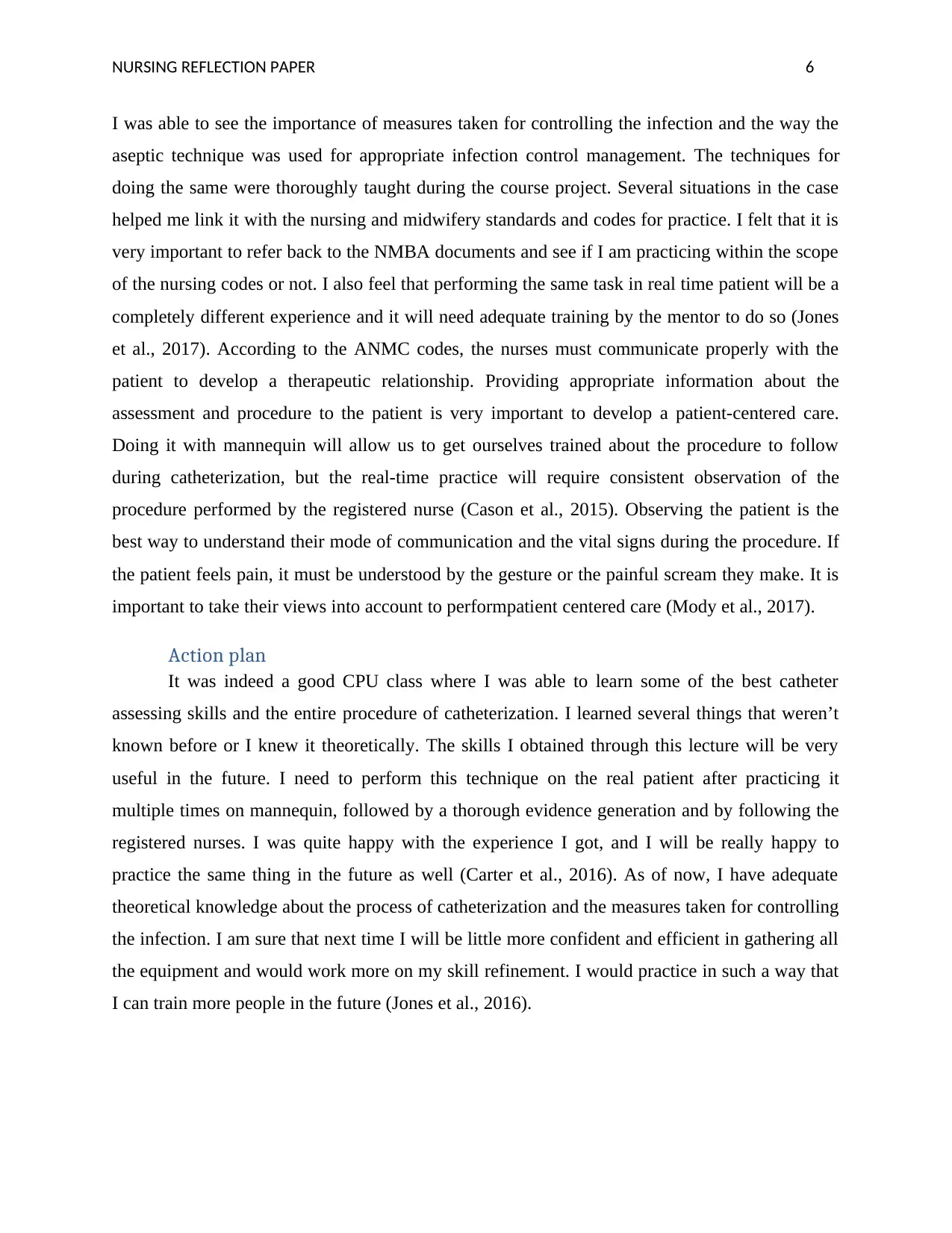
NURSING REFLECTION PAPER 6
I was able to see the importance of measures taken for controlling the infection and the way the
aseptic technique was used for appropriate infection control management. The techniques for
doing the same were thoroughly taught during the course project. Several situations in the case
helped me link it with the nursing and midwifery standards and codes for practice. I felt that it is
very important to refer back to the NMBA documents and see if I am practicing within the scope
of the nursing codes or not. I also feel that performing the same task in real time patient will be a
completely different experience and it will need adequate training by the mentor to do so (Jones
et al., 2017). According to the ANMC codes, the nurses must communicate properly with the
patient to develop a therapeutic relationship. Providing appropriate information about the
assessment and procedure to the patient is very important to develop a patient-centered care.
Doing it with mannequin will allow us to get ourselves trained about the procedure to follow
during catheterization, but the real-time practice will require consistent observation of the
procedure performed by the registered nurse (Cason et al., 2015). Observing the patient is the
best way to understand their mode of communication and the vital signs during the procedure. If
the patient feels pain, it must be understood by the gesture or the painful scream they make. It is
important to take their views into account to performpatient centered care (Mody et al., 2017).
Action plan
It was indeed a good CPU class where I was able to learn some of the best catheter
assessing skills and the entire procedure of catheterization. I learned several things that weren’t
known before or I knew it theoretically. The skills I obtained through this lecture will be very
useful in the future. I need to perform this technique on the real patient after practicing it
multiple times on mannequin, followed by a thorough evidence generation and by following the
registered nurses. I was quite happy with the experience I got, and I will be really happy to
practice the same thing in the future as well (Carter et al., 2016). As of now, I have adequate
theoretical knowledge about the process of catheterization and the measures taken for controlling
the infection. I am sure that next time I will be little more confident and efficient in gathering all
the equipment and would work more on my skill refinement. I would practice in such a way that
I can train more people in the future (Jones et al., 2016).
I was able to see the importance of measures taken for controlling the infection and the way the
aseptic technique was used for appropriate infection control management. The techniques for
doing the same were thoroughly taught during the course project. Several situations in the case
helped me link it with the nursing and midwifery standards and codes for practice. I felt that it is
very important to refer back to the NMBA documents and see if I am practicing within the scope
of the nursing codes or not. I also feel that performing the same task in real time patient will be a
completely different experience and it will need adequate training by the mentor to do so (Jones
et al., 2017). According to the ANMC codes, the nurses must communicate properly with the
patient to develop a therapeutic relationship. Providing appropriate information about the
assessment and procedure to the patient is very important to develop a patient-centered care.
Doing it with mannequin will allow us to get ourselves trained about the procedure to follow
during catheterization, but the real-time practice will require consistent observation of the
procedure performed by the registered nurse (Cason et al., 2015). Observing the patient is the
best way to understand their mode of communication and the vital signs during the procedure. If
the patient feels pain, it must be understood by the gesture or the painful scream they make. It is
important to take their views into account to performpatient centered care (Mody et al., 2017).
Action plan
It was indeed a good CPU class where I was able to learn some of the best catheter
assessing skills and the entire procedure of catheterization. I learned several things that weren’t
known before or I knew it theoretically. The skills I obtained through this lecture will be very
useful in the future. I need to perform this technique on the real patient after practicing it
multiple times on mannequin, followed by a thorough evidence generation and by following the
registered nurses. I was quite happy with the experience I got, and I will be really happy to
practice the same thing in the future as well (Carter et al., 2016). As of now, I have adequate
theoretical knowledge about the process of catheterization and the measures taken for controlling
the infection. I am sure that next time I will be little more confident and efficient in gathering all
the equipment and would work more on my skill refinement. I would practice in such a way that
I can train more people in the future (Jones et al., 2016).
Paraphrase This Document
Need a fresh take? Get an instant paraphrase of this document with our AI Paraphraser
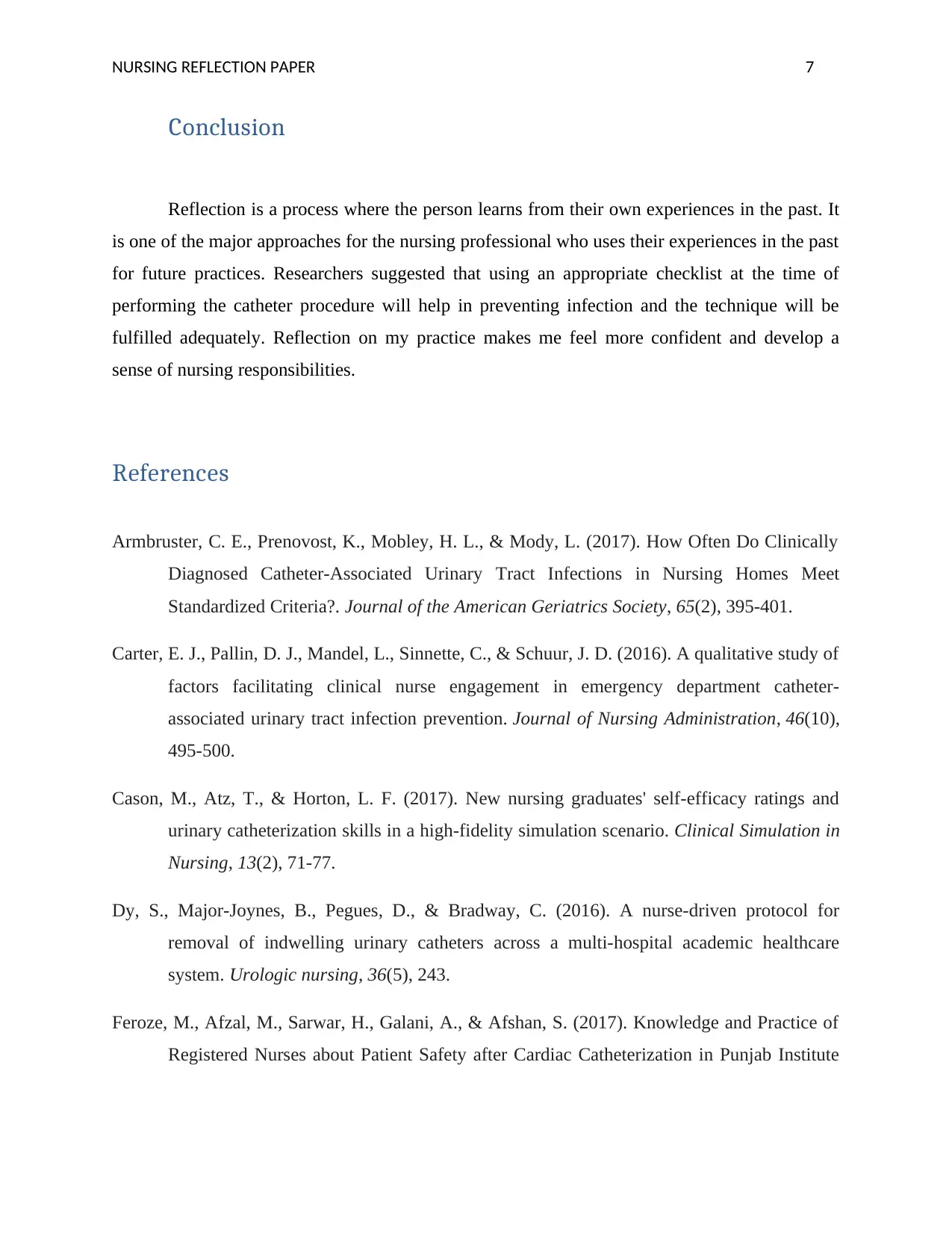
NURSING REFLECTION PAPER 7
Conclusion
Reflection is a process where the person learns from their own experiences in the past. It
is one of the major approaches for the nursing professional who uses their experiences in the past
for future practices. Researchers suggested that using an appropriate checklist at the time of
performing the catheter procedure will help in preventing infection and the technique will be
fulfilled adequately. Reflection on my practice makes me feel more confident and develop a
sense of nursing responsibilities.
References
Armbruster, C. E., Prenovost, K., Mobley, H. L., & Mody, L. (2017). How Often Do Clinically
Diagnosed Catheter‐Associated Urinary Tract Infections in Nursing Homes Meet
Standardized Criteria?. Journal of the American Geriatrics Society, 65(2), 395-401.
Carter, E. J., Pallin, D. J., Mandel, L., Sinnette, C., & Schuur, J. D. (2016). A qualitative study of
factors facilitating clinical nurse engagement in emergency department catheter-
associated urinary tract infection prevention. Journal of Nursing Administration, 46(10),
495-500.
Cason, M., Atz, T., & Horton, L. F. (2017). New nursing graduates' self-efficacy ratings and
urinary catheterization skills in a high-fidelity simulation scenario. Clinical Simulation in
Nursing, 13(2), 71-77.
Dy, S., Major-Joynes, B., Pegues, D., & Bradway, C. (2016). A nurse-driven protocol for
removal of indwelling urinary catheters across a multi-hospital academic healthcare
system. Urologic nursing, 36(5), 243.
Feroze, M., Afzal, M., Sarwar, H., Galani, A., & Afshan, S. (2017). Knowledge and Practice of
Registered Nurses about Patient Safety after Cardiac Catheterization in Punjab Institute
Conclusion
Reflection is a process where the person learns from their own experiences in the past. It
is one of the major approaches for the nursing professional who uses their experiences in the past
for future practices. Researchers suggested that using an appropriate checklist at the time of
performing the catheter procedure will help in preventing infection and the technique will be
fulfilled adequately. Reflection on my practice makes me feel more confident and develop a
sense of nursing responsibilities.
References
Armbruster, C. E., Prenovost, K., Mobley, H. L., & Mody, L. (2017). How Often Do Clinically
Diagnosed Catheter‐Associated Urinary Tract Infections in Nursing Homes Meet
Standardized Criteria?. Journal of the American Geriatrics Society, 65(2), 395-401.
Carter, E. J., Pallin, D. J., Mandel, L., Sinnette, C., & Schuur, J. D. (2016). A qualitative study of
factors facilitating clinical nurse engagement in emergency department catheter-
associated urinary tract infection prevention. Journal of Nursing Administration, 46(10),
495-500.
Cason, M., Atz, T., & Horton, L. F. (2017). New nursing graduates' self-efficacy ratings and
urinary catheterization skills in a high-fidelity simulation scenario. Clinical Simulation in
Nursing, 13(2), 71-77.
Dy, S., Major-Joynes, B., Pegues, D., & Bradway, C. (2016). A nurse-driven protocol for
removal of indwelling urinary catheters across a multi-hospital academic healthcare
system. Urologic nursing, 36(5), 243.
Feroze, M., Afzal, M., Sarwar, H., Galani, A., & Afshan, S. (2017). Knowledge and Practice of
Registered Nurses about Patient Safety after Cardiac Catheterization in Punjab Institute
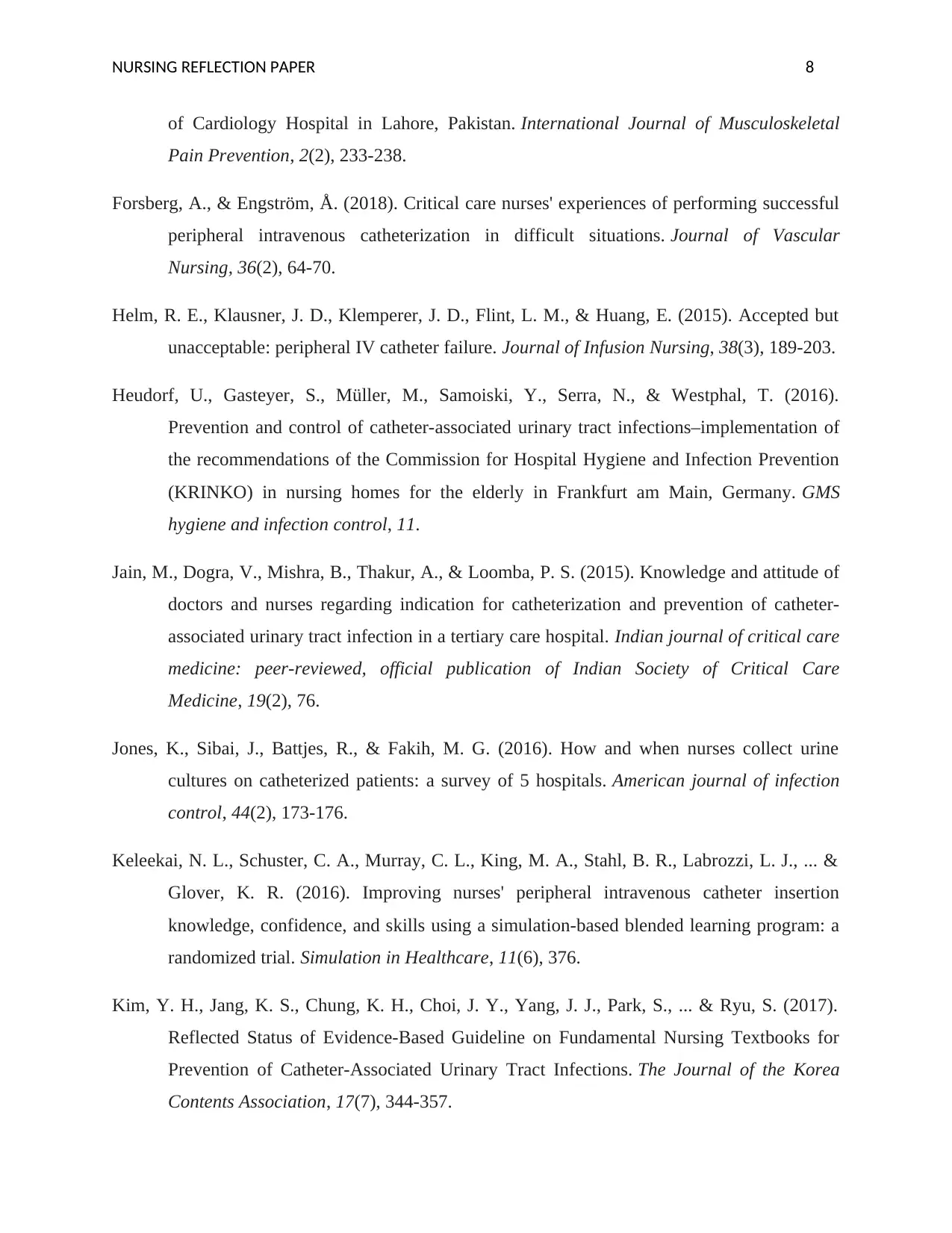
NURSING REFLECTION PAPER 8
of Cardiology Hospital in Lahore, Pakistan. International Journal of Musculoskeletal
Pain Prevention, 2(2), 233-238.
Forsberg, A., & Engström, Å. (2018). Critical care nurses' experiences of performing successful
peripheral intravenous catheterization in difficult situations. Journal of Vascular
Nursing, 36(2), 64-70.
Helm, R. E., Klausner, J. D., Klemperer, J. D., Flint, L. M., & Huang, E. (2015). Accepted but
unacceptable: peripheral IV catheter failure. Journal of Infusion Nursing, 38(3), 189-203.
Heudorf, U., Gasteyer, S., Müller, M., Samoiski, Y., Serra, N., & Westphal, T. (2016).
Prevention and control of catheter-associated urinary tract infections–implementation of
the recommendations of the Commission for Hospital Hygiene and Infection Prevention
(KRINKO) in nursing homes for the elderly in Frankfurt am Main, Germany. GMS
hygiene and infection control, 11.
Jain, M., Dogra, V., Mishra, B., Thakur, A., & Loomba, P. S. (2015). Knowledge and attitude of
doctors and nurses regarding indication for catheterization and prevention of catheter-
associated urinary tract infection in a tertiary care hospital. Indian journal of critical care
medicine: peer-reviewed, official publication of Indian Society of Critical Care
Medicine, 19(2), 76.
Jones, K., Sibai, J., Battjes, R., & Fakih, M. G. (2016). How and when nurses collect urine
cultures on catheterized patients: a survey of 5 hospitals. American journal of infection
control, 44(2), 173-176.
Keleekai, N. L., Schuster, C. A., Murray, C. L., King, M. A., Stahl, B. R., Labrozzi, L. J., ... &
Glover, K. R. (2016). Improving nurses' peripheral intravenous catheter insertion
knowledge, confidence, and skills using a simulation-based blended learning program: a
randomized trial. Simulation in Healthcare, 11(6), 376.
Kim, Y. H., Jang, K. S., Chung, K. H., Choi, J. Y., Yang, J. J., Park, S., ... & Ryu, S. (2017).
Reflected Status of Evidence-Based Guideline on Fundamental Nursing Textbooks for
Prevention of Catheter-Associated Urinary Tract Infections. The Journal of the Korea
Contents Association, 17(7), 344-357.
of Cardiology Hospital in Lahore, Pakistan. International Journal of Musculoskeletal
Pain Prevention, 2(2), 233-238.
Forsberg, A., & Engström, Å. (2018). Critical care nurses' experiences of performing successful
peripheral intravenous catheterization in difficult situations. Journal of Vascular
Nursing, 36(2), 64-70.
Helm, R. E., Klausner, J. D., Klemperer, J. D., Flint, L. M., & Huang, E. (2015). Accepted but
unacceptable: peripheral IV catheter failure. Journal of Infusion Nursing, 38(3), 189-203.
Heudorf, U., Gasteyer, S., Müller, M., Samoiski, Y., Serra, N., & Westphal, T. (2016).
Prevention and control of catheter-associated urinary tract infections–implementation of
the recommendations of the Commission for Hospital Hygiene and Infection Prevention
(KRINKO) in nursing homes for the elderly in Frankfurt am Main, Germany. GMS
hygiene and infection control, 11.
Jain, M., Dogra, V., Mishra, B., Thakur, A., & Loomba, P. S. (2015). Knowledge and attitude of
doctors and nurses regarding indication for catheterization and prevention of catheter-
associated urinary tract infection in a tertiary care hospital. Indian journal of critical care
medicine: peer-reviewed, official publication of Indian Society of Critical Care
Medicine, 19(2), 76.
Jones, K., Sibai, J., Battjes, R., & Fakih, M. G. (2016). How and when nurses collect urine
cultures on catheterized patients: a survey of 5 hospitals. American journal of infection
control, 44(2), 173-176.
Keleekai, N. L., Schuster, C. A., Murray, C. L., King, M. A., Stahl, B. R., Labrozzi, L. J., ... &
Glover, K. R. (2016). Improving nurses' peripheral intravenous catheter insertion
knowledge, confidence, and skills using a simulation-based blended learning program: a
randomized trial. Simulation in Healthcare, 11(6), 376.
Kim, Y. H., Jang, K. S., Chung, K. H., Choi, J. Y., Yang, J. J., Park, S., ... & Ryu, S. (2017).
Reflected Status of Evidence-Based Guideline on Fundamental Nursing Textbooks for
Prevention of Catheter-Associated Urinary Tract Infections. The Journal of the Korea
Contents Association, 17(7), 344-357.
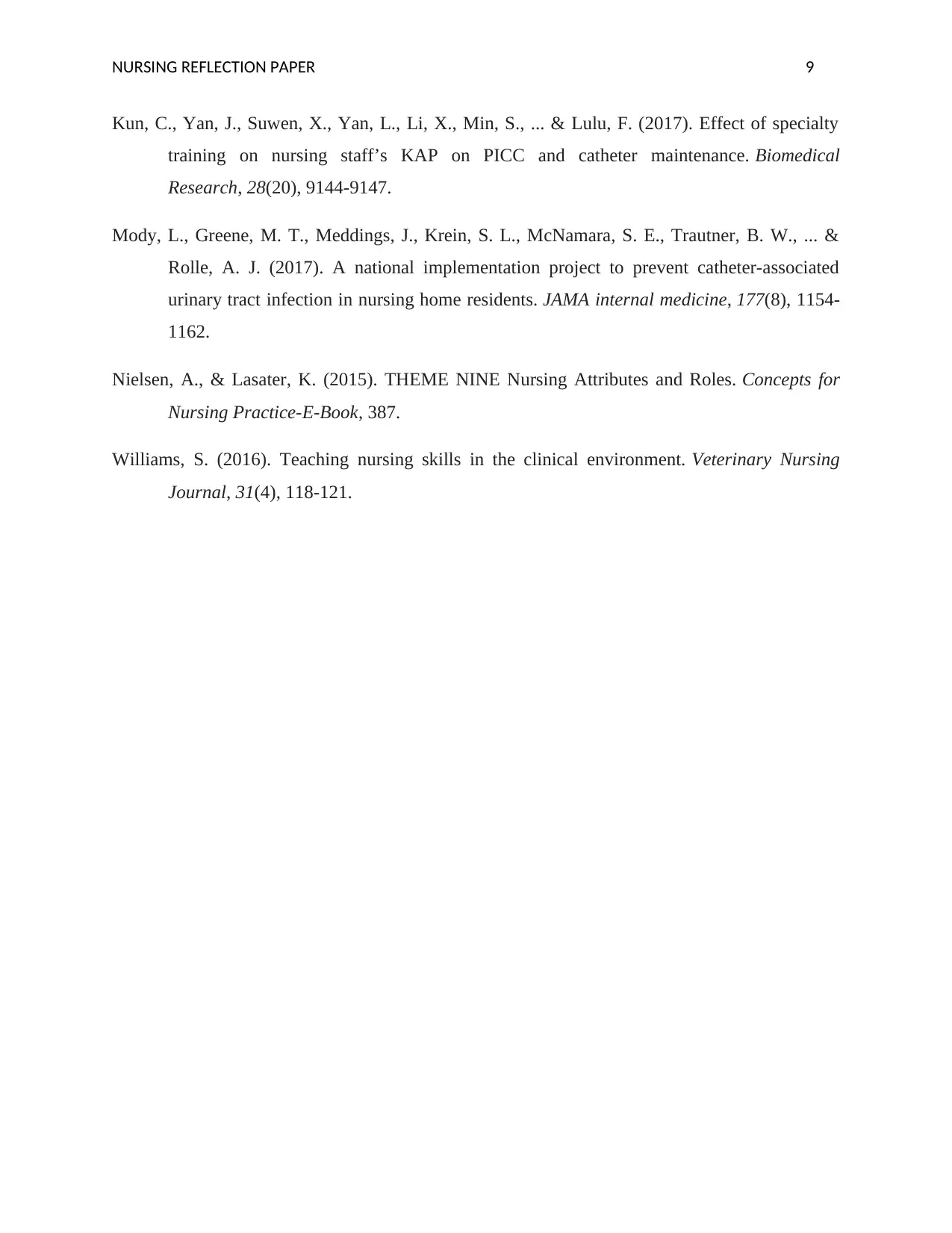
NURSING REFLECTION PAPER 9
Kun, C., Yan, J., Suwen, X., Yan, L., Li, X., Min, S., ... & Lulu, F. (2017). Effect of specialty
training on nursing staff’s KAP on PICC and catheter maintenance. Biomedical
Research, 28(20), 9144-9147.
Mody, L., Greene, M. T., Meddings, J., Krein, S. L., McNamara, S. E., Trautner, B. W., ... &
Rolle, A. J. (2017). A national implementation project to prevent catheter-associated
urinary tract infection in nursing home residents. JAMA internal medicine, 177(8), 1154-
1162.
Nielsen, A., & Lasater, K. (2015). THEME NINE Nursing Attributes and Roles. Concepts for
Nursing Practice-E-Book, 387.
Williams, S. (2016). Teaching nursing skills in the clinical environment. Veterinary Nursing
Journal, 31(4), 118-121.
Kun, C., Yan, J., Suwen, X., Yan, L., Li, X., Min, S., ... & Lulu, F. (2017). Effect of specialty
training on nursing staff’s KAP on PICC and catheter maintenance. Biomedical
Research, 28(20), 9144-9147.
Mody, L., Greene, M. T., Meddings, J., Krein, S. L., McNamara, S. E., Trautner, B. W., ... &
Rolle, A. J. (2017). A national implementation project to prevent catheter-associated
urinary tract infection in nursing home residents. JAMA internal medicine, 177(8), 1154-
1162.
Nielsen, A., & Lasater, K. (2015). THEME NINE Nursing Attributes and Roles. Concepts for
Nursing Practice-E-Book, 387.
Williams, S. (2016). Teaching nursing skills in the clinical environment. Veterinary Nursing
Journal, 31(4), 118-121.
1 out of 10
Related Documents
Your All-in-One AI-Powered Toolkit for Academic Success.
+13062052269
info@desklib.com
Available 24*7 on WhatsApp / Email
![[object Object]](/_next/static/media/star-bottom.7253800d.svg)
Unlock your academic potential
© 2024 | Zucol Services PVT LTD | All rights reserved.





